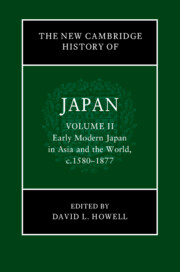Book contents
- The New Cambridge History of Japan
- The New Cambridge History of Japan
- The New Cambridge History of Japan
- Copyright page
- Contents
- Figures
- Maps
- Tables
- Contributors to Volume II
- Preface
- Frontispiece
- Introduction
- Part I The Character of the Early Modern State
- PART II Economy, Environment, and Technology
- Part III Social Practices and Cultures of Early Modern Japan
- 13 Religion in the Tokugawa Period
- 14 The Medical Revolution in Early Modern Japan
- 15 Flows of People and Things in Early Modern Japan
- 16 Labor and Migration in Tokugawa Japan
- 17 The Tokugawa Status Order
- 18 On the Peripheries of the Japanese Archipelago
- 19 The Early Modern City in Japan
- 20 Popular Movements in Early Modern Japan
- 21 Civilization and Enlightenment in Early Meiji Japan
- Index
- References
18 - On the Peripheries of the Japanese Archipelago
Ryukyu and Hokkaido
from Part III - Social Practices and Cultures of Early Modern Japan
Published online by Cambridge University Press: 15 January 2024
- The New Cambridge History of Japan
- The New Cambridge History of Japan
- The New Cambridge History of Japan
- Copyright page
- Contents
- Figures
- Maps
- Tables
- Contributors to Volume II
- Preface
- Frontispiece
- Introduction
- Part I The Character of the Early Modern State
- PART II Economy, Environment, and Technology
- Part III Social Practices and Cultures of Early Modern Japan
- 13 Religion in the Tokugawa Period
- 14 The Medical Revolution in Early Modern Japan
- 15 Flows of People and Things in Early Modern Japan
- 16 Labor and Migration in Tokugawa Japan
- 17 The Tokugawa Status Order
- 18 On the Peripheries of the Japanese Archipelago
- 19 The Early Modern City in Japan
- 20 Popular Movements in Early Modern Japan
- 21 Civilization and Enlightenment in Early Meiji Japan
- Index
- References
Summary
Any national history project faces the dilemma of what to include when current national boundaries do not coincide with historical ones. In Japan, the identity of the nation with its dominant ethnic group in the modern period has turned every discussion of “Japanese” history into an implicit comment on what and who is meant by “Japanese.” This chapter surveys the histories of Ryukyu and Hokkaido through the premodern and early modern periods. It discusses both regions’ close ties to the Japanese polity, while also highlighting their autonomous histories. At the same time, it reveals how situating places like Ryukyu and Hokkaido inside or outside the early modern polity shapes our understanding of their status during the modern era as colonial possessions or integral parts of the Japanese nation. This situating in turn affects understandings of the Indigeneity of the Ainu people and the status of Okinawan language and culture.
Keywords
- Type
- Chapter
- Information
- The New Cambridge History of Japan , pp. 603 - 628Publisher: Cambridge University PressPrint publication year: 2023



